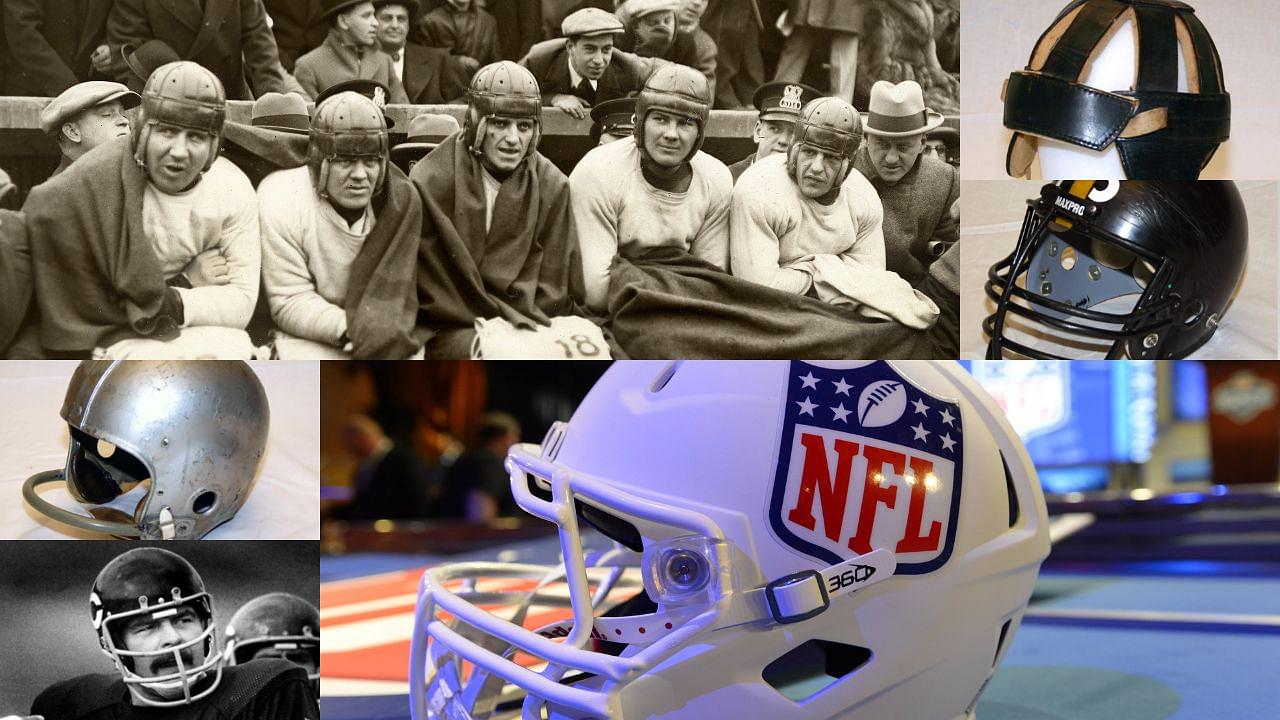The evolution of football helmets is a tale of evolution and progress that could easily be turned into a Netflix documentary. The invention of these protective headgear transformed the modern game in the NFL into a safer sport. Due to these rule changes, many types of injuries have seen a decline. However, the lingering threat of head trauma still persists.
Advertisement
If we peek into any player’s locker these days, we’ll find an array of over a dozen items. Each of these items is carefully crafted to provide safety to the players with high-level performance, comfort, and style. Amongst all these gears, the helmet stands out as the linchpin. Let’s take a look at how the helmets have changed with the modernization of the sport.
The Evolution of the NFL Helmets
.
.
.
.#nfl #NFLPlayoffs #SuperBowl
(via: https://t.co/pRRWefbX8r) pic.twitter.com/kjdvlwhFiN— Yagya Bhargava (@YagyaBhargava) February 7, 2024
The tale of football helmets began in Springfield, Massachusetts, way back in 1891. The illustrious James Naismith, also known as the “Father of Basketball,” was actively involved as the center of the YMCA College team. Naismith found himself in dire need of protective gear as he suffered multiple collisions in order to protect his quarterback.
He thought of a solution and asked his girlfriend to whip up a makeshift helmet. Little did he know, his girlfriend’s quick thinking and sewing skills got him the very first football helmet made out of two flannel pieces. Moreover, this game-changing innovation revolutionized the sport in itself.
NFL Helmets (1890-1940)
A visionary, George Barclay, is often credited to be the man behind the invention of the very first proper headgear, which he began wearing in 1984. The “head harness” consisted of three sturdy leather straps that were designed to protect the head during fierce tackles. However, even his invention was a product of US Naval Academy Midshipman Joseph M. Reeves’s idea that introduced leather in helmets.
When Reeves received a chilling warning from his doctor about a potentially life-threatening injury on the gridiron. He sought out a local blacksmith to create a makeshift leather helmet for him to participate in the Army-Navy game. From these humble beginnings, football helmets became much more sophisticated and better equipped to protect these players. It can be stated as the Leather Helmet Era.
By the early 1900s, the helmets kept on adding extra padding, flaps, and ear holes. These adjustments made the helmets more comfortable and burly, and most importantly, they made communication better on the field. There was just one issue that the quarterbacks were facing at that time, not being able to differentiate between the receivers and opponent defenders. Then followed the tradition of painted helmets.
The painted helmets, mostly boasting of the team logo, helped the players identify their team members from a distance. With that, we cannot forget mentioning Los Angeles Rams‘ Fred Gehrke, who, in 1948, pioneered the practice of painting distinctive logos onto team helmets. In a way, he breathed new life into the sport with his creative touch.
NFL Helmets (Late 1930s–Early 1970s)
In the late 1930s, it became very frequent that the players suffered injuries to their exposed faces. It led to the revolutionary addition of facemasks to helmets. A sports salesman, Vern McMillan, brought in a rubber-covered wire apparatus to protect the players’ faces. The first facemask featuring a helmet had a single bar running down the face, providing better protection for the nose.
After seeing the level of protection these helmets provided, the NCAA mandated the use of helmets for all players during games. That’s when things took off! A Chicago-based company began the mass production of helmets made out of plastic, incorporating facemasks and chinstraps.
They offered unparalleled strength compared to their earlier counterparts. These helmets became the standard protection for players by the 1940s. In 1943, the NFL also made it mandatory for all players to wear these protective gear and that was indeed the turning point. The franchises started painting their logos and color schemes on their helmets.
It added a touch of flair and suave to the game, reshaping the way teams looked overall. As science advanced, inventors tried hard plastic shells alone to ensure players’ safety. Following that, in the early 1970s, air pockets were added to the helmet design, further enhancing head protection and providing an extra layer of safety against impacts.
Now, it’s hard to imagine a time when football players didn’t have facemasks or plastic on their helmets.
NFL Helmets (Late 1970s–Present)
In the late 1970s, the NFL world saw tougher aesthetic and creative structural integrity in the helmets with the introduction of stainless-steel facemasks. After a few years, companies turned toward a lightweight and resilient plastic, polycarbonate. It gradually became the go-to material for helmet shells.
Moreover, this shift towards polycarbonate paved the way for the football helmets we see being used nowadays. These helmets have, all the more, continued to evolve throughout the 2000s with a detailed focus on protecting athletes from concussion catastrophes more than skull damage.
A company named Xenith then came along with a shock matrix technology in 2006 and shook up the American helmet industry. Their X1 helmets triggered a huge shift in the market as they were more durable. From a humble flannel cap crafted by Naismith’s girlfriend to a projected $185,570,000 American football helmet market by 2030, the industry has really undergone an astounding transformation.





